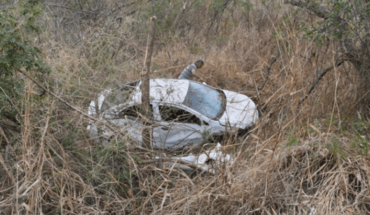Is considered one of the most iconic images of the TWENTIETH century . However, little or nothing is known of its protagonist, neither in China, nor in the rest of the world.
The identity and whereabouts of the nicknamed “Tank Man”, which is still one of the greatest symbols of peaceful resistance, is a mystery.
On June 3 and 4, 1989, the Chinese army was ordered to end the citizen protest that had been occupying the emblematic Tiananmen square in the heart of Beijing for almost seven weeks and had already spread to other parts of the country.
In Beijing, protesters reached the million, something unprecedented in post-Mao China.
They asked for greater freedoms, to end corruption and greater transparency of the authorities, among other demands.
After the violent repression that occurred in the night of June 3-4, 1989-and that ended with an indeterminate number of dead, that some sources are in the hundreds or even thousands, the morning of June 5 produced the image that became world famous.
A lone protester was placed in front of a tank leading the line of military vehicles that at that time crossed Chang An Avenue, Beijing’s main avenue that crosses Tiananmen Square.
Every time the vehicle tried to pass, the man moved sideways to put himself in front of the armoured.
The scene lasted a little less than two minutes; The man gets to climb the tank and two people end up Llevándoselo.
The image, which was captured and preserved by some cameramen, turned the world around.
According to some witnesses, “The Tank Man” was not the only one who protested those days that he faced the army.
“I witnessed a lot of people who stood up, blocking the tanks,” says Shao Jiang, a Chinese student leader in 1989, in a video of Amnesty International.
Who was that?
Thirty years after that image, nothing is known about its protagonist yet.
“Most likely he was a student because he was a young man, but no one knows for sure,” says BBC Chinese service editor Jinxi Cao.
Most of the theories are inclined because the lone protester was one of the students who took weeks taking the streets of the country to ask for greater freedom. It is, in fact, one of the most sustained theories.
No one, at least publicly, has been able to identify him so far. The British tabloid Sunday Express He said in an article of 1989 that the famous man in the photo was Wang Weilin, a 19-year-old Chinese student, who according to his friends, had been executed.
But the then-Secretary-General of the Chinese Communist Party, Jiang Zemin, denied knowledge of the young man’s arrest or name.
Other theories poured out in different media suggest that it could be a young worker who had joined the protests or simply someone who wanted to show his opposition to the massacre, which remains a taboo in China and of which the government never or Freció an official number of victims.
What happened to the lone protester?
The fate of the also known as “Unknown Rebel” is another mystery.
The video shows how, after being repeatedly in front of the tank, and even after getting on to talk to a member of the army, several young people appear on the scene.
Former Chinese president Jiang Zemin, sitting here on the right side of President Xi Jinping, denied knowing the identity or whereabouts of the young man in photography. First one on a bicycle, dressed in light colors, who stops to talk to the lone protester. Then two other young men dressed in blue, running towards him raising their hands in an apparent gesture aimed at the military.
They’re the ones who take the tank man.
But then, what happened to the unknown protester?
“I don’t think he was killed (…) People in the tanks did not want to run over those who stood in the way, “Jiang Zemin responded to questions from journalists a year after the incident, according to various press reports.
The Chinese authorities have never recognised any death in the events of 3 and 4 June, but according to different sources, the deceased were able to oscillate between the hundreds and the thousands. The British newspaper The Times He came to publish an article quoting police sources that claimed that “they could not find it either between the dead or those who were in prison.”
So some people think the tank man is still alive.
“Some theories place it on the island of Taiwan; And others argue that it really could not be located and lives in the interior of the country in the most absolute anonymity, as defends the work Red China Blues, by historian Jan Wong.
But the hypothesis that has more strength points out that he was executed. According to the British newspaper The Independent, Bruce Herschensohn, former Deputy special assistant to American ex-president Richard Nixon, said so during a speech at a private club.
But it is information that has not been confirmed.
Forced to Oblivion
In China, his image is unknown to many… Or that is what they assure in front of the chambers, in the midst of a strict censure on this controversial chapter of the recent history of the country.
“In the weeks leading up to June 4th, the world’s largest censorship machinery is operationalized and it activates its huge network of automated algorithms and tens of thousands of human purgers who clean up any reference on the Internet, although not Be direct, “writes BBC correspondent John Sudworth from Beijing.
“Any reference is prohibited,” delves from the Chinese service Jinxi Cao, “and those who skip restrictions, can be easily tracked and arrested.”
The weeks before June 4, controls in China Harden, in physical places but also on the net. A BBC team in the Asian giant went out to ask people if they recognized the famous image of the tank. Of the respondents, only two people said yes and some recriminated the journalist to risk teaching that image in public.
Cao explains that “many young people should no longer know who they are, because China’s Great Firewall has been working brilliantly for years (…), but middle-aged folks may know what that image means, but prefer not to recognize it.”
This is how, the Tank Man, named by Time Magazine one of the most influential people of the TWENTIETH century, is doomed to oblivion in his own country.
translated from Spanish: 30 years of the Tiananmen massacre: What is known about the “Tank Man”, which became a symbol of protests around the world
June 4, 2019 |





